
Andrejs Strokins and The Laboratory of Manuel Bürger Collaboratoires MB,
Courtesy of Riga International Biennial of Contemporary Art
UNPICKING POTENTIALS AT RIGA BIENNIAL OF ART
Arguably, silence is a form of life stripped to a bare minimum, our lungs take a breath and pause before exhaling again. Carried inside a biological mechanism by which we inhabit the world, silence is a hidden space shared with all living and non-living organisms. It is something so intimate and familiar yet it can be altered and intensified as a choice, a tool and a weapon in between a right for self-protection and an engine of oppression. It might be the case that in our new collective reality silence is partially democratized as we adjust to the ruptures in the social realm, reconfiguring the most contemporary layers of our society such as nightclubbing and flying into radically political acts. Particularly resonant within this renewed context, silence reminds us of the need to descale and economize, and in the case of second Riga biennale (RIBOCA2) a potential to turn fragility into a constructive force.
The young Riga biennale is part of a new wave of regional platforms aimed at creating more sustainable models in a cultural environment saturated with easily recycled schemes. To write about this year’s Riga biennale (RIBOCA2), which was able to take place under the long shadow of indefinite postponements elsewhere, is to give acknowledgement to the presence of the unfinished, the reconfigured and the reimagined that the curator Rebecca Lamarche-Vadel and her team turned to embrace. Nowhere is the exhibition’s esoteric title and suddenly it all blossoms as manifested as across the idly blossoming fields of Andrejsala, an abandoned historical industrial port whose vast grounds provide a central setting for the exhibition. Here within the dystopian surrounding of an abandoned backyard (which also opens up as a prelude to the main venue), the exhibition affords ample space for the artworks to expose the nuances and multiplicities of a dialogue with historical, the socio-political and the geographical. Traversing wild plants, flowers frothing yellow and red, derelict dwellings and muggy soil, a tension between abandon and intimacy, control and expansion unfolds.
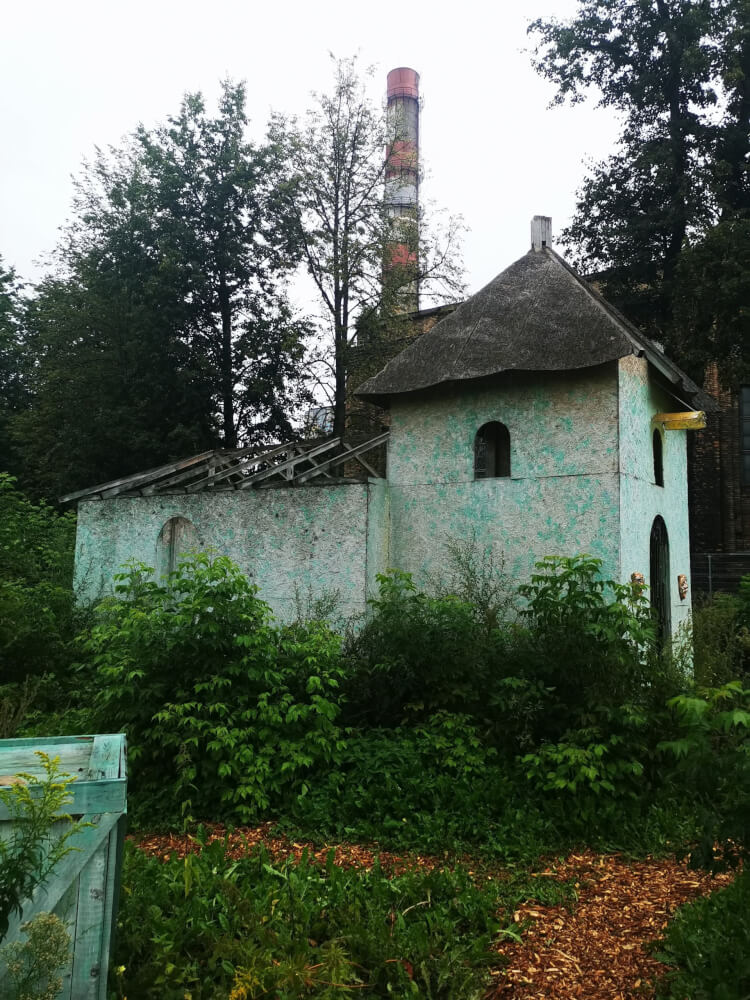
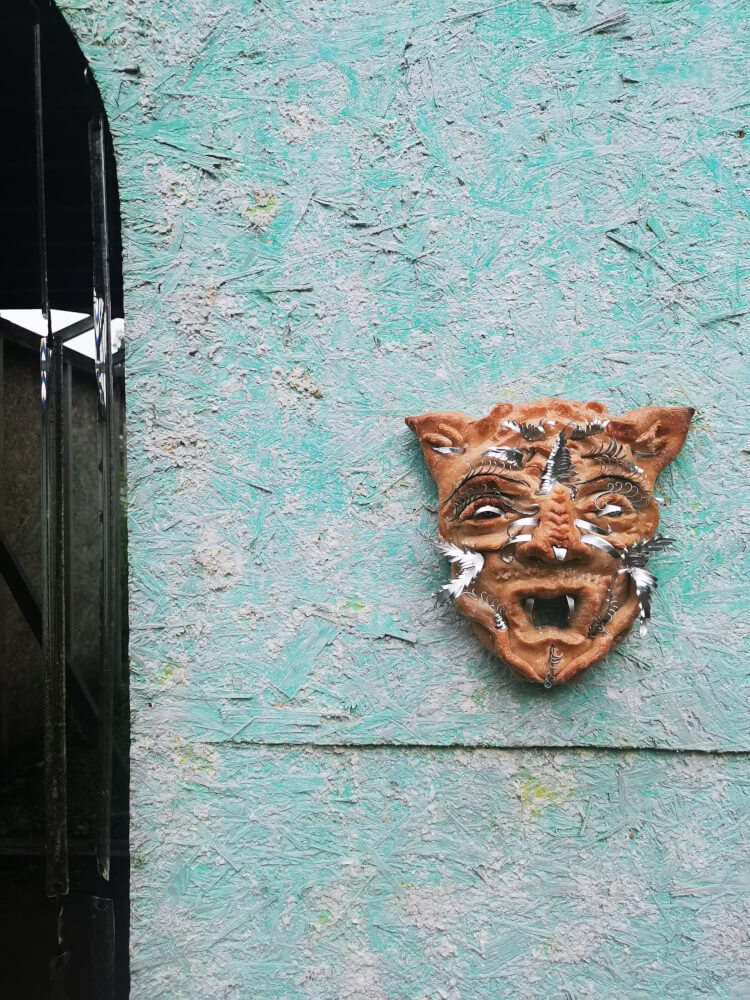
Habitaball, Anastasia Sosunova
Photo: Nina Vukelić
Anastasia Sosunova’s installation Habitatball choreographs a chain of intimate encounters cutting through the flourishing greenery, True Detective eeriness, roofless wooden dwellings and traces of fictionalized communities. The artist intervenes in the existing structures domesticating them with hybrid sculptures featuring Dionysian faces made of baked salt bread and adorned with metal elements, suspended somewhere between organic fragility and cyborg artifice. Heinz Frank’s architectural drawings on the other hand highlight the silent quality of small scale works on paper, while humbly eluding illustration. These rough sketches exist inside a blurry area, merging and dissolving the animal features with architectural forms. His works confront the easy recognition of animals as buildings, they seem to contain riddles and bring to light his interest in rethinking architecture from alternative perspectives.
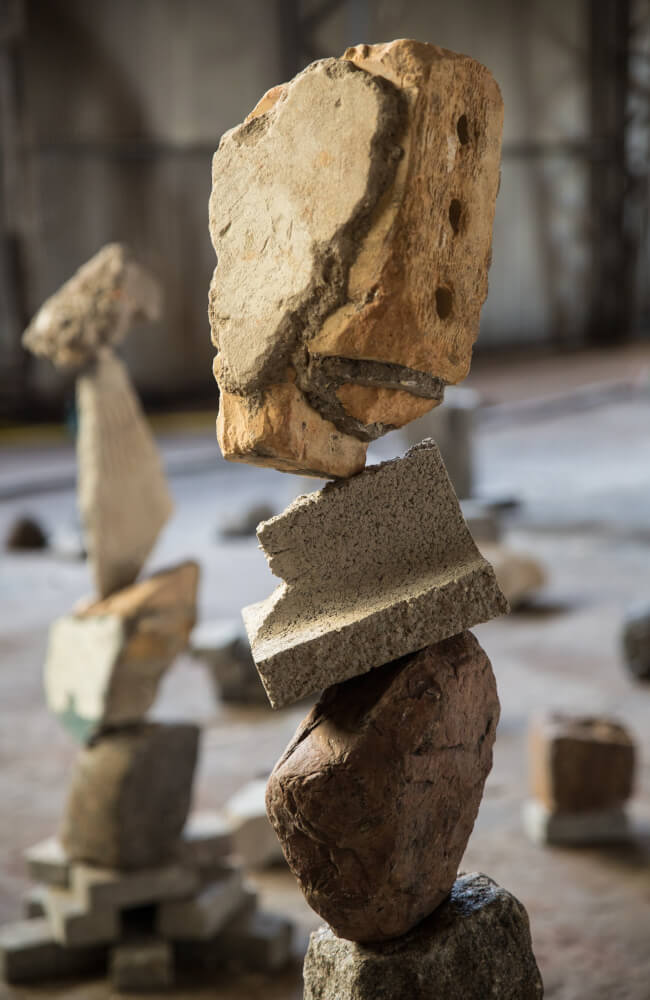
Balancing Rocks and Rubble, Bridget Polk,
courtesy of riga biennial of contemporary art
Given the central stage in one of the hangars, Bridget Polk’s collection of Balancing Rocks demands a watchful presence that renegotiates modernist abstraction into a balancing act. Part guardians’ part casual observers Polk’s army of material gathered on-site (a combination of industrial rubble and stones) reworks gravitational forces daily as the artist is present on-site, testing and demonstrating new compositions. At its inception, Bridget Polk employed this laborious form of sculpture that runs counter to the accepted notion of construction in art and elsewhere as a means to mental health. The pairing of stones as a labour founded on patience rather than force could be read as a search for consolation to the dire extinction moment we are living in where many feel pulled into collective despair. Here in Riga, her ephemeral, paradoxical monuments captivate with the possibility of equilibrium as well as the danger of collapse.
Long before Andrejsala was engineered into an industrial port via developing dams on the Daugava river, the area carried an aura of calm, pastoral delta surrounding the city’s walls. Lina Lapelyte and Mantas Petraitis installation Currents brings together over 2,000 pine logs, creating a floating body of wood that offers a reflection on man’s past relationship with the environment and revives the encounter with the history of tinder trade defining Baltic economies since Middle Ages. What was once an embodied routine grounded in the practice of (mostly) men steering the logs into the world on the engine of river currents, is now reframed as a living sculpture enclosed within the artificial dam, a result of efforts to expand Andrejsala’s harbour.
Flows of information and data that shape our technologically saturated society appear easily malleable and open to errors and manipulation under the touch of the human hand. Clay, by contrast, is a strong and resistant medium that one transforms only with care. In Katrin Hornek landscape of clay the artist unearths a large lump of Latvian soil inviting the visitors to walk, smell, touch and listen as meditative speculative fiction streams from the headphones. “Hi, come closer. Take a look around. I wanna show you something. For the next 30 minutes, I will take you on a journey. The clay in the room will be our guide“, whispers a soft voice, taking the listener on a multisensory narrative descending into a geological existence of earth, evoking subterranean worlds intertwined with politics of natural gas extraction, fertilizer corruption and industrialization.
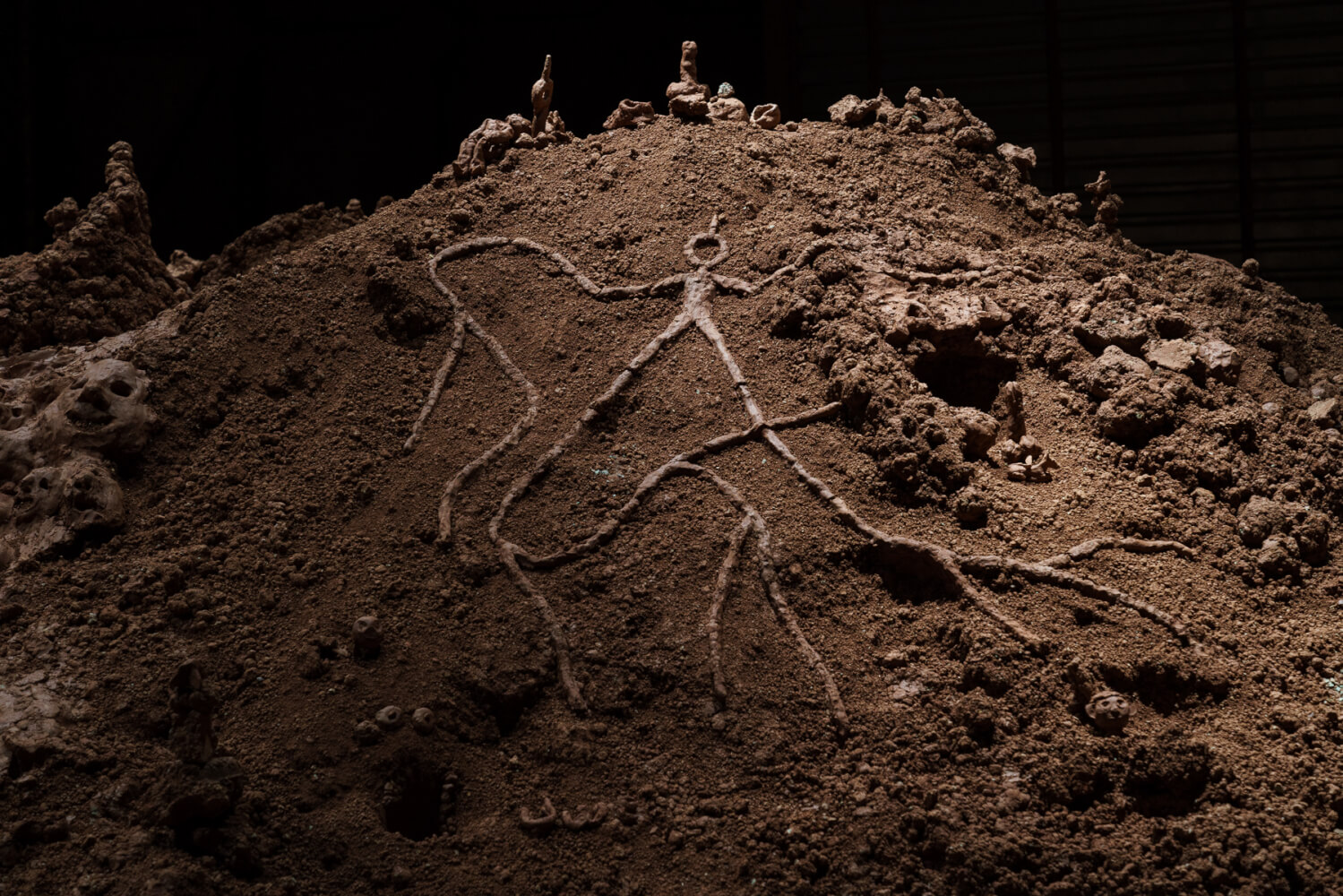
A Landmass To Come (detail), Katrin Hornek
photo: Andrejs Strokins
In the years to come shades of brown will prevail across the natural colour spectrum as the ice gives away under the threat of increasingly rising temperatures. Historically, snow features as a central reference point in Latvian literature and poetry yet this year the sight of it was unusually scarce. For the local artist Augustas Serapine the extreme conditions generated new perspectives, calling for a rethinking of the original project. Serapine intended his contribution to unfold as a response to an outpour of snowmen swarming the streets of Riga during winter months, he planned to replicate them in different materials. Instead, Serapinas turned to work with the existing material – soil, covering the exhibition space with a body of mud and hay figures.
Our ability to reuse the resources at hand will come to define our endurance as species on this planet. For Visitation Zone Edith Dekyndt engaged in parallel acts of preservation; making visible a bed of segments of dust and dirt accumulated on-site over the years on top of which she placed glass vitrines filled with fermented products (tied to the region’s pickling heritage). It serves as a reminder that in giving presence to the neglected we might uncover the processes that decelerate time, offering a potential to heal thoughts and map out an alternative existence for imagining another future.
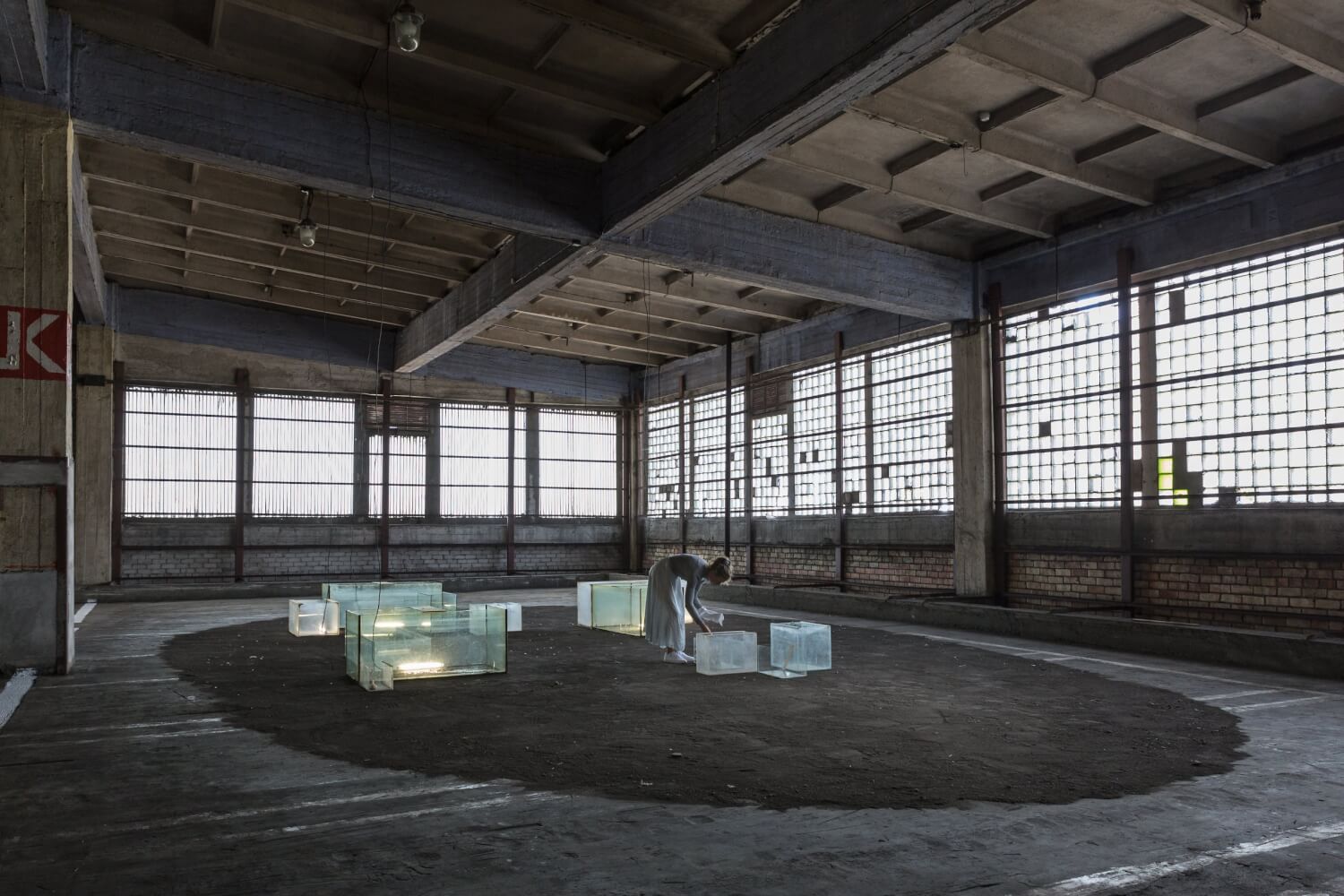
Visitation Zone, Edith Dekyndt
courtesy of riga biennial of contemporary art
Text: Nina Vukelić

Andrejs Strokins and The Laboratory of Manuel Bürger Collaboratoires MB,
Courtesy of Riga International Biennial of Contemporary Art
UNPICKING POTENTIALS AT RIGA BIENNIAL OF ART
Arguably, silence is a form of life stripped to a bare minimum, our lungs take a breath and pause before exhaling again. Carried inside a biological mechanism by which we inhabit the world, silence is a hidden space shared with all living and non-living organisms. It is something so intimate and familiar yet it can be altered and intensified as a choice, a tool and a weapon in between a right for self-protection and an engine of oppression. It might be the case that in our new collective reality silence is partially democratized as we adjust to the ruptures in the social realm, reconfiguring the most contemporary layers of our society such as nightclubbing and flying into radically political acts. Particularly resonant within this renewed context, silence reminds us of the need to descale and economize, and in the case of second Riga biennale (RIBOCA2) a potential to turn fragility into a constructive force.
The young Riga biennale is part of a new wave of regional platforms aimed at creating more sustainable models in a cultural environment saturated with easily recycled schemes. To write about this year’s Riga biennale (RIBOCA2), which was able to take place under the long shadow of indefinite postponements elsewhere, is to give acknowledgement to the presence of the unfinished, the reconfigured and the reimagined that the curator Rebecca Lamarche-Vadel and her team turned to embrace. Nowhere is the exhibition’s esoteric title and suddenly it all blossoms as manifested as across the idly blossoming fields of Andrejsala, an abandoned historical industrial port whose vast grounds provide a central setting for the exhibition. Here within the dystopian surrounding of an abandoned backyard (which also opens up as a prelude to the main venue), the exhibition affords ample space for the artworks to expose the nuances and multiplicities of a dialogue with historical, the socio-political and the geographical. Traversing wild plants, flowers frothing yellow and red, derelict dwellings and muggy soil, a tension between abandon and intimacy, control and expansion unfolds.


Habitaball, Anastasia Sosunova
Photo: Nina Vukelić
Anastasia Sosunova’s installation Habitatball choreographs a chain of intimate encounters cutting through the flourishing greenery, True Detective eeriness, roofless wooden dwellings and traces of fictionalized communities. The artist intervenes in the existing structures domesticating them with hybrid sculptures featuring Dionysian faces made of baked salt bread and adorned with metal elements, suspended somewhere between organic fragility and cyborg artifice. Heinz Frank’s architectural drawings on the other hand highlight the silent quality of small scale works on paper, while humbly eluding illustration. These rough sketches exist inside a blurry area, merging and dissolving the animal features with architectural forms. His works confront the easy recognition of animals as buildings, they seem to contain riddles and bring to light his interest in rethinking architecture from alternative perspectives.

Balancing Rocks and Rubble, Bridget Polk,
courtesy of riga biennial of contemporary art
Given the central stage in one of the hangars, Bridget Polk’s collection of Balancing Rocks demands a watchful presence that renegotiates modernist abstraction into a balancing act. Part guardians’ part casual observers Polk’s army of material gathered on-site (a combination of industrial rubble and stones) reworks gravitational forces daily as the artist is present on-site, testing and demonstrating new compositions. At its inception, Bridget Polk employed this laborious form of sculpture that runs counter to the accepted notion of construction in art and elsewhere as a means to mental health. The pairing of stones as a labour founded on patience rather than force could be read as a search for consolation to the dire extinction moment we are living in where many feel pulled into collective despair. Here in Riga, her ephemeral, paradoxical monuments captivate with the possibility of equilibrium as well as the danger of collapse.
Long before Andrejsala was engineered into an industrial port via developing dams on the Daugava river, the area carried an aura of calm, pastoral delta surrounding the city’s walls. Lina Lapelyte and Mantas Petraitis installation Currents brings together over 2,000 pine logs, creating a floating body of wood that offers a reflection on man’s past relationship with the environment and revives the encounter with the history of tinder trade defining Baltic economies since Middle Ages. What was once an embodied routine grounded in the practice of (mostly) men steering the logs into the world on the engine of river currents, is now reframed as a living sculpture enclosed within the artificial dam, a result of efforts to expand Andrejsala’s harbour.
Flows of information and data that shape our technologically saturated society appear easily malleable and open to errors and manipulation under the touch of the human hand. Clay, by contrast, is a strong and resistant medium that one transforms only with care. In Katrin Hornek landscape of clay the artist unearths a large lump of Latvian soil inviting the visitors to walk, smell, touch and listen as meditative speculative fiction streams from the headphones. “Hi, come closer. Take a look around. I wanna show you something. For the next 30 minutes, I will take you on a journey. The clay in the room will be our guide“, whispers a soft voice, taking the listener on a multisensory narrative descending into a geological existence of earth, evoking subterranean worlds intertwined with politics of natural gas extraction, fertilizer corruption and industrialization.

A Landmass To Come (detail), Katrin Hornek
photo: Andrejs Strokins
In the years to come shades of brown will prevail across the natural colour spectrum as the ice gives away under the threat of increasingly rising temperatures. Historically, snow features as a central reference point in Latvian literature and poetry yet this year the sight of it was unusually scarce. For the local artist Augustas Serapine the extreme conditions generated new perspectives, calling for a rethinking of the original project. Serapine intended his contribution to unfold as a response to an outpour of snowmen swarming the streets of Riga during winter months, he planned to replicate them in different materials. Instead, Serapinas turned to work with the existing material – soil, covering the exhibition space with a body of mud and hay figures.
Our ability to reuse the resources at hand will come to define our endurance as species on this planet. For Visitation Zone Edith Dekyndt engaged in parallel acts of preservation; making visible a bed of segments of dust and dirt accumulated on-site over the years on top of which she placed glass vitrines filled with fermented products (tied to the region’s pickling heritage). It serves as a reminder that in giving presence to the neglected we might uncover the processes that decelerate time, offering a potential to heal thoughts and map out an alternative existence for imagining another future.

Visitation Zone, Edith Dekyndt
courtesy of riga biennial of contemporary art
Text: Nina Vukelić

